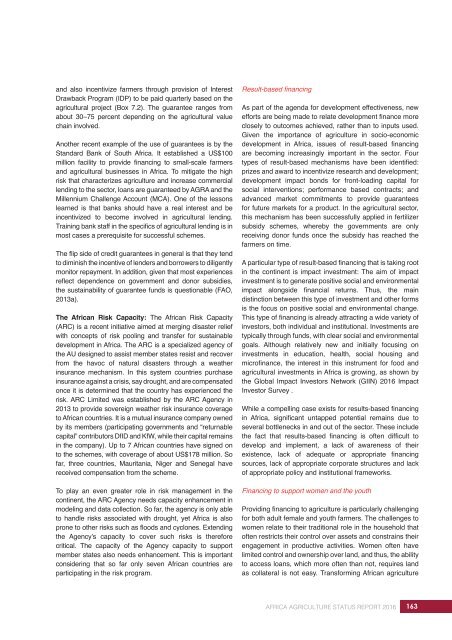AFRICA AGRICULTURE STATUS REPORT 2016
AASR-report_2016-1
AASR-report_2016-1
Create successful ePaper yourself
Turn your PDF publications into a flip-book with our unique Google optimized e-Paper software.
and also incentivize farmers through provision of Interest<br />
Drawback Program (IDP) to be paid quarterly based on the<br />
agricultural project (Box 7.2). The guarantee ranges from<br />
about 30–75 percent depending on the agricultural value<br />
chain involved.<br />
Another recent example of the use of guarantees is by the<br />
Standard Bank of South Africa. It established a US$100<br />
million facility to provide financing to small-scale farmers<br />
and agricultural businesses in Africa. To mitigate the high<br />
risk that characterizes agriculture and increase commercial<br />
lending to the sector, loans are guaranteed by AGRA and the<br />
Millennium Challenge Account (MCA). One of the lessons<br />
learned is that banks should have a real interest and be<br />
incentivized to become involved in agricultural lending.<br />
Training bank staff in the specifics of agricultural lending is in<br />
most cases a prerequisite for successful schemes.<br />
The flip side of credit guarantees in general is that they tend<br />
to diminish the incentive of lenders and borrowers to diligently<br />
monitor repayment. In addition, given that most experiences<br />
reflect dependence on government and donor subsidies,<br />
the sustainability of guarantee funds is questionable (FAO,<br />
2013a).<br />
The African Risk Capacity: The African Risk Capacity<br />
(ARC) is a recent initiative aimed at merging disaster relief<br />
with concepts of risk pooling and transfer for sustainable<br />
development in Africa. The ARC is a specialized agency of<br />
the AU designed to assist member states resist and recover<br />
from the havoc of natural disasters through a weather<br />
insurance mechanism. In this system countries purchase<br />
insurance against a crisis, say drought, and are compensated<br />
once it is determined that the country has experienced the<br />
risk. ARC Limited was established by the ARC Agency in<br />
2013 to provide sovereign weather risk insurance coverage<br />
to African countries. It is a mutual insurance company owned<br />
by its members (participating governments and “returnable<br />
capital” contributors DfID and KfW, while their capital remains<br />
in the company). Up to 7 African countries have signed on<br />
to the schemes, with coverage of about US$178 million. So<br />
far, three countries, Mauritania, Niger and Senegal have<br />
received compensation from the scheme.<br />
To play an even greater role in risk management in the<br />
continent, the ARC Agency needs capacity enhancement in<br />
modeling and data collection. So far, the agency is only able<br />
to handle risks associated with drought, yet Africa is also<br />
prone to other risks such as floods and cyclones. Extending<br />
the Agency’s capacity to cover such risks is therefore<br />
critical. The capacity of the Agency capacity to support<br />
member states also needs enhancement. This is important<br />
considering that so far only seven African countries are<br />
participating in the risk program.<br />
Result-based financing<br />
As part of the agenda for development effectiveness, new<br />
efforts are being made to relate development finance more<br />
closely to outcomes achieved, rather than to inputs used.<br />
Given the importance of agriculture in socio-economic<br />
development in Africa, issues of result-based financing<br />
are becoming increasingly important in the sector. Four<br />
types of result-based mechanisms have been identified:<br />
prizes and award to incentivize research and development;<br />
development impact bonds for front-loading capital for<br />
social interventions; performance based contracts; and<br />
advanced market commitments to provide guarantees<br />
for future markets for a product. In the agricultural sector,<br />
this mechanism has been successfully applied in fertilizer<br />
subsidy schemes, whereby the governments are only<br />
receiving donor funds once the subsidy has reached the<br />
farmers on time.<br />
A particular type of result-based financing that is taking root<br />
in the continent is impact investment: The aim of impact<br />
investment is to generate positive social and environmental<br />
impact alongside financial returns. Thus, the main<br />
distinction between this type of investment and other forms<br />
is the focus on positive social and environmental change.<br />
This type of financing is already attracting a wide variety of<br />
investors, both individual and institutional. Investments are<br />
typically through funds, with clear social and environmental<br />
goals. Although relatively new and initially focusing on<br />
investments in education, health, social housing and<br />
microfinance, the interest in this instrument for food and<br />
agricultural investments in Africa is growing, as shown by<br />
the Global Impact Investors Network (GIIN) <strong>2016</strong> Impact<br />
Investor Survey .<br />
While a compelling case exists for results-based financing<br />
in Africa, significant untapped potential remains due to<br />
several bottlenecks in and out of the sector. These include<br />
the fact that results-based financing is often difficult to<br />
develop and implement, a lack of awareness of their<br />
existence, lack of adequate or appropriate financing<br />
sources, lack of appropriate corporate structures and lack<br />
of appropriate policy and institutional frameworks.<br />
Financing to support women and the youth<br />
Providing financing to agriculture is particularly challenging<br />
for both adult female and youth farmers. The challenges to<br />
women relate to their traditional role in the household that<br />
often restricts their control over assets and constrains their<br />
engagement in productive activities. Women often have<br />
limited control and ownership over land, and thus, the ability<br />
to access loans, which more often than not, requires land<br />
as collateral is not easy. Transforming African agriculture<br />
<strong>AFRICA</strong> <strong>AGRICULTURE</strong> <strong>STATUS</strong> <strong>REPORT</strong> <strong>2016</strong><br />
163


